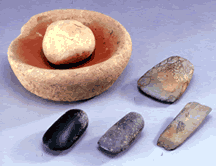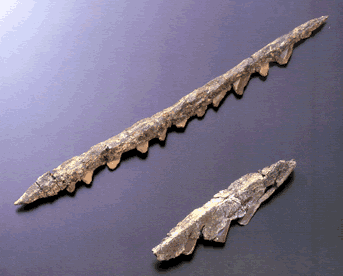
 |
|
The early agricultural society that developed wheat cultivation in South Asia had not yet discovered metal tools. Instead these early farmers used sickles made of small stone blades inserted diagonally into wooden sticks for harvesting cereals. These composite tools were reusable as the original blades could be replaced with new ones when the old ones were broken. Sickles that were used for reaping wheat often still have silica from the ancient wheat stems adhered to the blade, which produces a sheen that is visible to the naked eye. Stone arrowheads were also used, and some of the arrowheads were decorated with artwork. Asphalt or bitumen was utilized to help secure these stone tools (blades and arrowheads) to the wooden components of composite tools and weapons. |
|

|
|
[home] [prev] [next] |
|
| [Environment] [The dawn of civilization] [Indus Civilization] [The successors] | |
